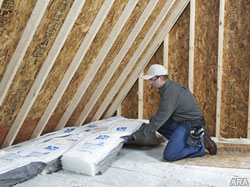
(ARA) – Getting ready for the coldest months of the year means a lot of things. You need to get warm clothes out of storage, decorate for the holidays and, of course, make sure your house keeps out drafts that can make you shiver and drive up utility bills. While it might seem like a lot to take on, prepping your home for winter doesn’t need to take a lot of time or cost a small fortune.
Sprucing up your home with seasonal decor is great for creating a cozy feeling, but you need to pay just as much attention to what you can’t see. To make your home a warm and inviting haven, think about what’s behind the walls and in the attic – and how you can save energy. After all, what you can’t see can often ends up costing you a lot of money.
To get started on weatherizing your home for fall and winter, follow these energy-efficient tips:
* Find hidden energy leaks in your home. A thermal leak detector that senses changes in temperature can help you find where your home’s weak spots are.
* Insulate. The Department of Energy recommends that you have approximately 19 inches of insulation in your attic. According to the EPA, adding insulation to your home can save your family up to $200 a year on utility bills. For the average attic that has existing insulation, you will need to add R-30 unfaced insulation. The greater the material’s R-value, the better it performs as an insulator. For more information about how to insulate your home, visit lowes.com/insulation.
* Caulk and seal. Gaps, cracks and holes let the warm air out and the cold air in, making your home drafty and sending your energy bills sky high. Air leaks from windows and doors are easy to find because they are easy to feel. Install weather strip or caulk to seal the frame. Air leaks in your attic or basement are harder to find, but cost you a lot in warmth and money. Take time to search your attic and basement so that you can find hidden energy leaks, especially along ducts and vents. A quick fix for these trouble spots is insulating foam sealant.
* Give your windows a check-up. If you’re handy and your windows have seen better days, installing new windows is a good project to take on. Replace single-paned windows that waste energy and require a lot of maintenance with maintenance-free vinyl windows that have many energy-efficient features. For additional savings, make sure the replacement windows you use are Energy Star-qualified models, like Pella’s ThermaStar windows. They can help you save up to $500 a year in energy bills, according to the EPA. With all windows, it’s important they’re installed properly. If you’re not sure of your abilities, call in a pro.
If you’re not sure of where to start with weatherization, there are plenty of resources. In addition to consulting the experts at your local home improvement store, you can find kits like “Weatherizing for Dummies” that will get you started with key items like weather strip, outlet sealers and caulk. With a few simple steps, your home will be more efficient – protecting you from high energy bills, as well as the cold of winter. For more ideas about increasing your home’s efficiency, go to www.lowes.com/31Ways.





